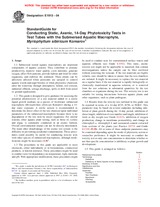Potřebujeme váš souhlas k využití jednotlivých dat, aby se vám mimo jiné mohly ukazovat informace týkající se vašich zájmů. Souhlas udělíte kliknutím na tlačítko „OK“.
ASTM E1913-04
Standard Guide for Conducting Static, Axenic, 14-Day Phytotoxicity Tests in Test Tubes with the Submersed Aquatic Macrophyte, Myriophyllum sibiricum Komarov
Automaticky přeložený název:
Standardní Příručka pro vedení statické, Axenic , 14-denní testy fytotoxicity ve zkumavkách s ponořené vodní makrofyt , Myriophyllum sibiricum Komárov
NORMA vydána dne 1.4.2004
Informace o normě:
Označení normy: ASTM E1913-04
Poznámka: NEPLATNÁ
Datum vydání normy: 1.4.2004
Kód zboží: NS-43545
Počet stran: 15
Přibližná hmotnost: 45 g (0.10 liber)
Země: Americká technická norma
Kategorie: Technické normy ASTM
Anotace textu normy ASTM E1913-04 :
Keywords:
aquatic toxicity testing, Myriophyllum sibiricum, phytotoxicity test, submersed aquatic macrophyte, ICS Number Code 13.060.70 (Examination of water for biological properties)
Doplňující informace
| 1. Scope | |||||||||||||||||||||||||||||||||||||||||||||||||||||||||||||||||||||||||||||||||
|
1.1 Submersed rooted aquatic macrophytes are important components of aquatic systems. They contribute to primary productivity, improve water quality, cycle nutrients, generate oxygen, affect flow patterns, provide habitat and food for other organisms, and stabilize the sediment. These plants can be adversely affected when pesticides are sprayed to control aquatic weeds and algal blooms or when phytotoxic chemicals enter the waterway through atmospheric fallout, soil erosion, industrial effluent, sewage discharge, spills or drift from aerial or ground applications. 1.2 This guide is designed to give guidance for assessing the potential phytotoxicity of a test material added to a sterile liquid growth medium on a certain species of freshwater submersed macrophyte ( Myriophyllum sibiricum Komarov) during a 14-day static exposure. A sterile system is recommended to determine the direct effect of the test chemical upon individual parameters of the submersed macrophyte. Overall environmental impact can not be directly determined. These procedures could possibly be useful for conducting toxicity tests with other species of submersed macrophytes, although modifications might be necessary (). 1.3 The procedures in this guide are applicable to most chemicals, either individually or in formulations, commercial products, or known mixtures. These procedures might be used to conduct tests for dependency on temperature, light, nutrients and pH. With appropriate modification, these procedures might be used to conduct tests for contaminated surface waters and aqueous effluents (see Guide E 1192). This static, axenic toxicity test might not be applicable to materials that contain microorganisms unless the sample can be filter sterilized without removing the toxicant. If the test materials are highly volatile, care should be taken to ensure that the test chambers are isolated. It might be necessary to replace the test material on a regular basis if the test material is rapidly biologically or chemically transformed in aqueous solution, or is removed from the test solutions in substantial quantities by the test chambers or organisms during the test. This toxicity test is not suitable for testing interactions between aquatic plants and other organisms, such as plant pathogens. 1.4 Results from the toxicity test outlined in this guide can be reported in terms of a 14-day IC25, IC50, or NOEC. This parameter may be based on several endpoints including inhibition of plant growth during the 14-day period, inhibition of shoot length, inhibition of root number and length, inhibition of fresh or dry weight (see Guide E 1415), inhibition of oxygen production, change in membrane permeability, and change in chlorophyll a, chlorophyll b and carotenoid content extracted from sections of the plants (see Practice D 3731 and Guide E 1218), (). All or some of these endpoint parameters may be examined depending upon the mode of phytotoxic action or researcher preference. It might be necessary to conduct the toxicity test at only one concentration to determine whether or not that specific concentration is inhibitory to plant growth and development. 1.5 This guide is arranged as follows:
1.6 The values stated in SI units are to be regarded as the standard. This standard does not purport to address all of the safety concerns, if any, associated with its use. It is the responsibility of the user of this standard to establish appropriate safety and health practices and determine the applicability of regulatory limitations prior to use. This standard may involve hazardous materials, operations, and equipment. See Section for specific hazard statements. |
|||||||||||||||||||||||||||||||||||||||||||||||||||||||||||||||||||||||||||||||||
| 2. Referenced Documents | |||||||||||||||||||||||||||||||||||||||||||||||||||||||||||||||||||||||||||||||||
|
Odebírejte informace o nově vydaných normách ZDARMA:
Chcete pravidelně odebírat informace o nově vycházejících normách z celého světa a to zcela zdarma?
Přihlašte se k odběru. Vše je velice jednoduché a absolutně ZDARMA.
Na výběr máte vydavatele z celého světa.




 Cookies
Cookies
